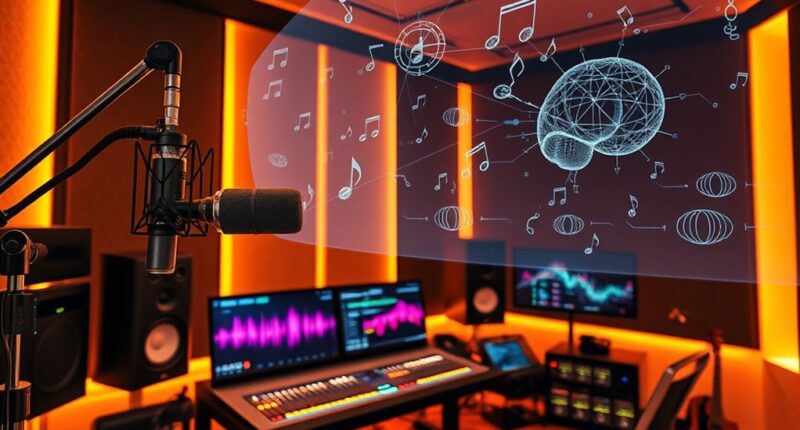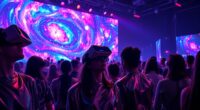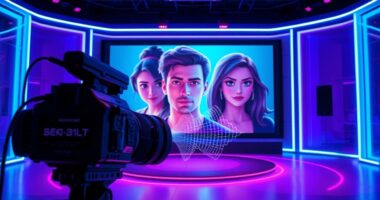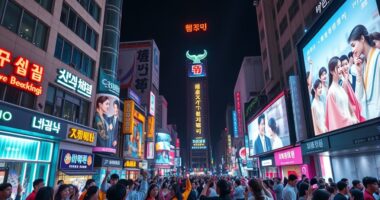Generative AI transforms your music creation process by helping you analyze, generate, and personalize melodies and rhythms effortlessly. It enables you to experiment with different styles, break creative blocks, and collaborate with intelligent algorithms that respond to your inputs. AI tools make music production more accessible, offering new ideas and expanding your artistic horizons. As AI continues evolving, it’s shaping a future where your creativity can reach new heights—discover what’s possible as you explore further.
Key Takeaways
- Generative AI analyzes extensive musical data to create new melodies, harmonies, and rhythms, expanding creative possibilities.
- It functions as a collaborative partner, inspiring experimentation with complex structures and unconventional sounds.
- AI personalizes outputs by learning from individual artists’ styles, enabling tailored and innovative musical ideas.
- AI democratizes music creation by lowering technical barriers, making production accessible to musicians of all skill levels.
- Evolving AI capabilities foster dynamic, iterative workflows, enhancing artistic exploration and the diversity of musical expression.
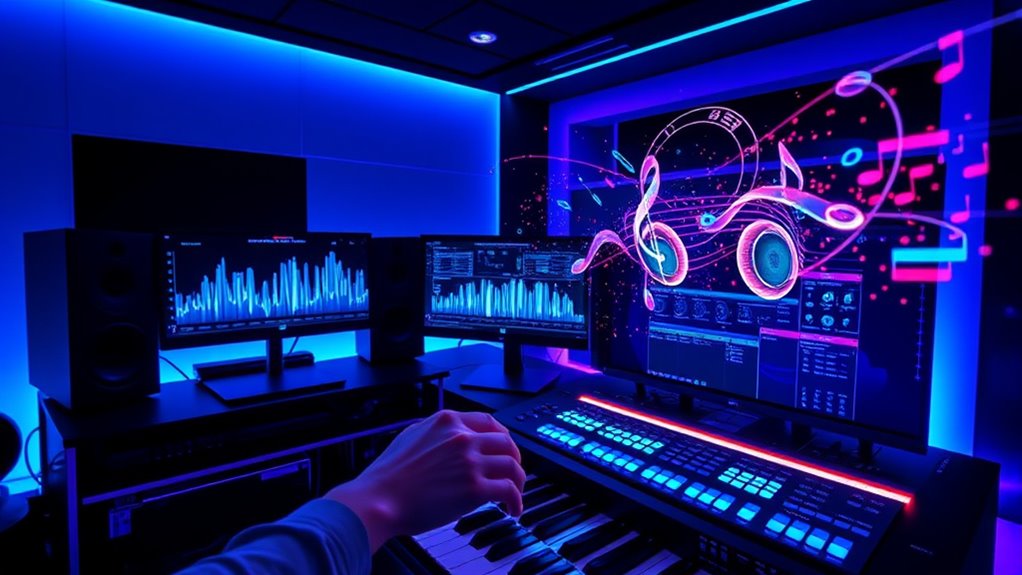
Generative AI is transforming how music is created, offering artists new tools to compose, produce, and experiment with sound. At the heart of this transformation are music algorithms that analyze vast amounts of data to generate melodies, harmonies, and rhythms. These algorithms can mimic various genres or invent entirely new styles, giving you a powerful way to expand your creative palette. Instead of starting from scratch, you can use AI to jumpstart your ideas, explore different musical directions, and break through creative blocks. By integrating AI-generated suggestions into your workflow, you’re not replacing your artistry but enhancing it, allowing for a more dynamic and iterative process.
One of the most exciting aspects of AI in music creation is its ability to foster creative collaboration. You can work alongside AI systems as if they’re fellow musicians, bouncing ideas back and forth, refining sounds, or testing new arrangements. This collaboration can be particularly helpful when you’re looking to experiment with complex structures or unconventional sounds without investing hours of manual effort. AI acts as a creative partner that responds to your inputs, offering suggestions that challenge your comfort zone and inspire new directions. The result is a symbiotic relationship where human intuition guides the AI’s outputs, and the AI, in turn, sparks fresh ideas you might not have discovered alone.
Moreover, music algorithms can adapt to your unique style, learning from your previous work to produce more personalized outputs. This adaptability makes AI a versatile co-creator, capable of aligning with your artistic vision or pushing it into unfamiliar territory. You can set parameters or simply let the algorithms generate spontaneous ideas, broadening your creative horizons. It’s like having a studio full of collaborators who are always ready to brainstorm at any hour, providing new motifs, textures, or rhythmic patterns that complement your existing compositions. Additionally, integrating insights from educational data mining can help artists better understand their creative process and improve their skills over time.
This synergy between human and machine is revolutionizing not just how music is made but also how it’s experienced. It democratizes the creative process by lowering technical barriers, enabling more musicians to realize their ideas without extensive training in production or composition. Whether you’re a seasoned artist or an aspiring musician, AI-driven music algorithms serve as powerful tools for innovation. They invite you to experiment boldly, collaborate seamlessly, and ultimately craft more diverse, complex, and compelling music. As AI continues to evolve, your capacity to create and collaborate will only expand, opening exciting new frontiers in music creation.
Frequently Asked Questions
How Does Generative AI Influence Traditional Music Composition Skills?
Generative AI influences your traditional music composition skills by expanding your creative intuition and challenging your musical intuition. It provides new ideas and patterns, encouraging you to experiment beyond conventional methods. While it can assist in generating melodies and harmonies, you still rely on your innate musical sense to craft expressive, meaningful music. AI becomes a tool that enhances your creativity, pushing you to explore innovative sounds and compositions.
Can Ai-Generated Music Replace Human Musicians Entirely?
You might think AI-generated music will replace human musicians, but only 10% of listeners prefer it over human-created tracks. AI and humans are better together, fostering collaboration that enhances creative autonomy. Instead of replacing, AI complements your skills, offering new ideas and tools. It empowers you to experiment more freely, making music more innovative while preserving the unique touch only you can provide.
What Ethical Concerns Arise From Ai-Created Music?
You should consider ethical concerns like copyright issues and cultural appropriation when dealing with AI-created music. AI can inadvertently use copyrighted material without proper authorization, risking legal trouble. It might also appropriate cultural elements without understanding their significance, leading to insensitivity. As a creator, you must navigate these issues responsibly, ensuring respect for original artists and cultures while embracing AI’s innovative potential.
How Accessible Is AI Music Creation for Independent Artists?
AI music creation tools are increasingly accessible for independent artists, enhancing music accessibility and fostering independent creativity. You can easily use user-friendly platforms and software to generate melodies, beats, or even full compositions without needing extensive technical skills. This democratizes music production, allowing you to experiment freely, produce high-quality tracks, and share your unique sound with the world, all while reducing barriers traditionally faced in the industry.
What Are the Future Trends in Ai-Driven Music Innovation?
Imagine a symphony where technology and human passion dance together. Future trends in AI-driven music innovation will see you harnessing AI collaboration, turning algorithms into your musical muse. You’ll explore new domains of sound through algorithmic creativity, breaking traditional boundaries. As AI becomes your partner, you’ll craft more personalized, immersive compositions, blurring the line between artist and machine. The future promises endless sonic possibilities, waiting for you to shape them.
Conclusion
As you explore the future of music with generative AI, one thing becomes clear: the boundaries are just beginning to blur. What melodies will emerge from this revolution? Will it inspire new genres or challenge your idea of creativity itself? The potential is vast—and it’s up to you to decide how you’ll harness this power. The next note, the next innovation, could change everything. Are you ready to see where this journey takes you?
